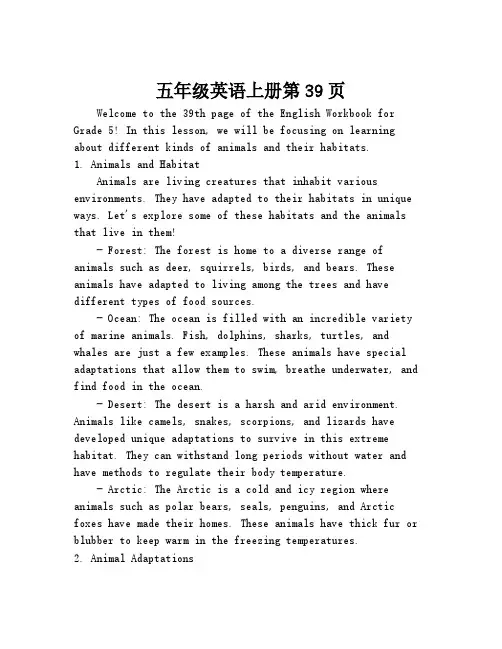通用五年级上册英语PPT课件(39)
- 格式:ppt
- 大小:923.00 KB
- 文档页数:2

五年级英语上册第39页Welcome to the 39th page of the English Workbook for Grade 5! In this lesson, we will be focusing on learning about different kinds of animals and their habitats.1. Animals and HabitatAnimals are living creatures that inhabit various environments. They have adapted to their habitats in unique ways. Let's explore some of these habitats and the animals that live in them!- Forest: The forest is home to a diverse range of animals such as deer, squirrels, birds, and bears. These animals have adapted to living among the trees and have different types of food sources.- Ocean: The ocean is filled with an incredible variety of marine animals. Fish, dolphins, sharks, turtles, and whales are just a few examples. These animals have special adaptations that allow them to swim, breathe underwater, and find food in the ocean.- Desert: The desert is a harsh and arid environment. Animals like camels, snakes, scorpions, and lizards have developed unique adaptations to survive in this extreme habitat. They can withstand long periods without water and have methods to regulate their body temperature.- Arctic: The Arctic is a cold and icy region where animals such as polar bears, seals, penguins, and Arctic foxes have made their homes. These animals have thick fur or blubber to keep warm in the freezing temperatures.2. Animal AdaptationsAnimals have adapted to their habitats in remarkable ways. Let's explore some of the adaptations that help them survive: - Camouflage: Many animals have the ability to blend in with their surroundings. This allows them to hide from predators or stalk their prey without being noticed. For example, chameleons can change their skin color to matchtheir environment.- Migration: Some animals have the instinct to travellong distances in search of food or better conditions. Birds, like geese, migrate to warmer climates during winter, while wildebeests in Africa migrate in search of fresh grazing land.- Hibernation: In colder climates, some animals enter a state of hibernation during winter. They lower their body temperature and metabolism to conserve energy. Bears and groundhogs are examples of animals that hibernate.3. Protecting Animal HabitatsIt is essential to protect and preserve animal habitatsto ensure the survival of various species. Here are some ways we can help:- Avoid littering: Properly dispose of waste to avoid polluting habitats and harming wildlife.- Plant trees: Trees provide shelter and food for many animals. Planting trees helps to restore and create habitats.- Support conservation efforts: Contribute toorganizations that work towards protecting endangered species and their habitats.Remember, every action we take can make a difference in preserving animal habitats and ensuring the survival of our planet's incredible wildlife.In conclusion, this lesson on animals and their habitats has given us insights into the diverse environments animalscall home and the amazing adaptations they possess. By understanding and appreciating these habitats, we can contribute to their preservation and create a harmonious coexistence with nature.。




